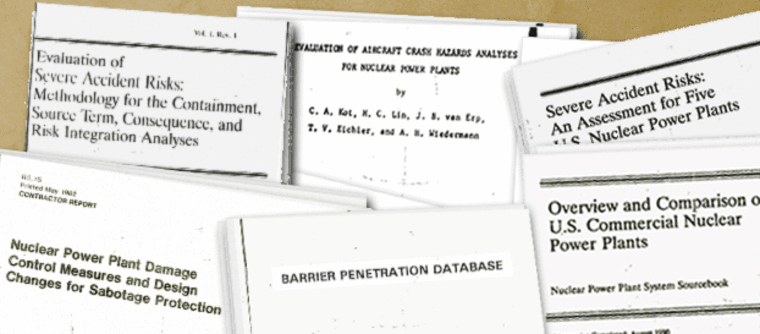What if an airplane were to crash into a nuclear plant? How long would it take terrorists to penetrate security barriers outside nuclear facilities? What are the most vulnerable parts of a nuclear plant to attack in order to inflict maximum damage?
The answers to all those questions, and many more, are available to the public, as NBC News discovered in a recent hidden-camera investigation. Accessing that very information — along with thousands of other sensitive documents from the Nuclear Regulatory Commission (NRC) — is as easy as walking into a public library, finding the right files, printing them out and walking out with the documents in hand, no questions asked.
Many of the documents we were able to access were among the thousands of files the NRC pulled from its Web site after 9/11, deemed too sensitive to be available to the public. But that same effort to clean out sensitive information, it seems, was never made with NRC’s document collections in public libraries across the country.
Former New Jersey Gov. Thomas Kean, who also served as co-chairman of the 9/11 commission, calls this inconsistency “appalling.”
“What this means is that we've given the terrorists an easy map in order to find out about our nuclear facilities,” says Kean. “It's the worst possible thing we could be doing.”
E-mails and letters obtained by NBC News show that after 9/11, the NRC did, in fact, compile a list of sensitive documents to be pulled from public collections. But in early 2002, the agency made the decision not to pull the information, so the request, and that list, were never passed on to libraries. The documents were never removed.
In fact, we were able to obtain documents from that very list at all four libraries we visited, and federal investigators were able to find sensitive security documents at all 25 libraries they visited. For security reasons, NBC News is not revealing the location of the libraries or the exact content of the documents.
In a statement to NBC News, the NRC says it is aware of a “limited amount” of sensitive information that continues to exist in the public domain, but that “the usefulness of this information is minimal given its age and subsequent changes to and improvements in security programs and physical modifications that have been made to nuclear facilities” since 9/11. The agency wishes “to assure the public that information directly related to the security programs and protection of nuclear power plants is not in the public domain.”
But Dave Lochbaum, a nuclear safety engineer with the Union of Concerned Scientists, insists the information in the public collections is “very explicit, very detailed, and would be very useful to the terrorists planning out such an attack.”
Lochbaum was recently able to buy an entire set of NRC’s document collection from a public library.
“Many of those records were pulled by the NRC from the main collection because of their value to terrorists,” says Lochbaum. “Yet here they were in the collection we obtained.”
Among the files he found in his new collection: the same documents the NRC removed from its Web site, including a 1982 report that details the catastrophic impact a plane crash could have if it hit at just the right point at a nuclear plant.
“That document, in pretty explicit detail, explains what the vulnerable parts of a plant are in terms of aircraft impact, so that would then become the targets for the pilot or the terrorist at the controls of an aircraft,” says Lochbaum. “That’s what he'd aim for.”
A prominent congressman agrees. Rep. Bart Gordon, D-Tenn., the ranking member of the House Committee on Science, recently wrote a letter to the NRC that describes the availability of all the sensitive nuclear data as "particularly troubling."
Gordon writes, "It is baffling to me that the NRC would consider this information so sensitive that it should be pulled from its on-line database, yet apparently the information was considered safe enough to be left in more than 80 public libraries scattered throughout the nation."
Gordon continues: "In my mind, the information can't be both a security threat and, simultaneously, of no consequence; a policy that treats the same materials in two different ways is simply muddled."
The NRC also claims that the limited accessibility of the documents was part of its decision to leave the information in the public realm. But Kean believes a difficult process is not necessarily sufficient deterrent to anyone determined to carry out a terror attack.
“What we learned in the 9/11 investigation was that these terrorists are smart, they're determined, they're willing to work as hard as necessary, they do their research, and they practice,” says Kean. “These are people who prepare very, very, very carefully. And so, if it's available and there's a way they can get it, they will.”
